
“Lieutenant Lund“
This fantastic article about the history of the Lt Lund I and Lt Lund II and Lt Lund III rebreather is written and published by Helmut Knüfermann. It is with great pleasure that I am able to offer the readers of my website this fantastic story thanks to Helmut’s generous offer that I could translate his article into English and display it on my website! Here is part 2 of a journey through time, thanks to Helmut!
Lieutenant Lund a Biography by Helmut Knüfermann
Biography of a creative and resourceful Norwegian naval officer (II)
In the first part of the Lieutenant Lund Biography Helmut Knüfermann reports on the development of the Kleintauchgerät 138 into the Lt. Lund II. Here is the continuation of one of the most interesting chapters in Norwegian Navy history:
Growing unity, new organizational form in 1956
Meanwhile the organizational form of the “Froskemannsskolen” changed. Theoretical training for new candidates took place in the MTMI, “Marinens Torpedo- og Mineinspeksjon”, while the “professional frogmen” were sent to the UVBI “Undervannsbåtinspeksjonen”. (submarine inspections). Not long after, the Navy High Command proposed (more than a directive to be implemented) that the entire school be integrated into the UVBI, both administratively and military-operationally. In a letter of the command, the future tasks of frogmen were also supplemented by the tasks of harbor and ship security. These planned and implemented changes immediately expanded Lieutenant Lund’s area of responsibility as Head of the Frogman School (see Figure 39 in part 1).
The boundaries of deep diving; ” Do you think a dive to 100 metres is reachable?”
Lund reports on his first experiences with mixed gas deep diving (NITROX) in an interview published by the Norwegian magazine “Vi Menn”. No. 5, in the Year 1956 [11] .
Ove Lund: “Diving has important physiological aspects – It is therefore necessary, to acquire a thorough knowledge of the human reactions to the pressure phenomena in water and the reaction to oxygen and gas mixtures that we use for breathing. It is important that we do not go deeper than what can be fully justified theoretically.”
Vi Menn: “Do you mean diving to 100 meters is reachable?”
“With the improvement of the breathing systems we’re experimenting with, I think we have the theory available for efficient dives down to 130 meters”.
Comment article: “That was indeed a surprising statement that will also interest frogmen worldwide. But especially Norwegian frogmen have to be able to dive twice as deep as in other countries because of the coastline”.
The magazine Vi man” writes further:
“Ove Lund was already at a greater depth. Together with Steinar Wickmann he went to significant deeper last year, using two different respirators for testing. The two brave frogmen decided to dive at 90 meters
– a terrible depth for a human body without special armored protection and with great dangers associated with the ascent”.
“Of course we had a standby diver on the surface etc” reports Lieutenant Lund.
“Within 3 minutes we reached 87 meters. It was pitch dark there and we read those depth markings on the safety line with our flashlights. We did not reach the planned 90 meter, because the wind to the surface wash increased. It ship above us started to sway and also began to drift. There were many bizarre experiences around us when we were at this considerable depth. At 80 meters our regulators behaved strangely. The heavy lung compression caused us to breathe ten times harder than on the surface. The air felt very thick and the regulator struggled to work so hard. We were out of breath, a feeling like after hard work. This despite the fact that we were almost motionless down there. We were both sick and dizzy, but also, elated, strangely enthusiastic and optimistic. Below us there was still a great depth and apart from jellyfish there was no other life to be seen in the black water.
The ascent took an hour. First we ascended at 10 meters per minute, then we stayed in the shallows for a long time suspended in water to decompress and to prevent diver diseases. The ascent depends only on the dive depth and the time spent at depth. In the future this will also be a natural part of our training. Effective diving to 130 meters is possible”.
New impulses: “The semi-closed rebreather”
In addition to the introduction of compressed air, in 1955 deep dives with gas mixtures other than air of atmospheric composition were evaluated in the “Froskemannsskolen”.
The areas and duties of the school, led by Lieutenant Lund, now include the training and use of frogmen for tactical defense tasks in shallow water, as well as divers for work to a depth of about 40 meters with diving equipment using compressed air. However, greater diving depths are required in special cases for effective coastal defense. So, Lund experimented with mixed gases in different concentration ratios of oxygen and nitrogen.
To do this, he modified a “Lieutenant Lund II” device with a breathing gas supply supplied by a hose from the surface (Figs. 40 and 41). He kept the standard pair of oxygen bottles, but fitted the breathing lung with a second pressure relief valve and connected the supply hose to the lower part of the breathing bag. The exact value of Lund’s O2/N2 composition is not known.
His dives with this configuration are also undocumented. The “Lieutenant Lund II” existing pressure regulator with constant flow and bypass valve is not seen in the available photographs. It is suspected that the percentage metering and quantity metering was taken over by a fixed pressure regulator mounted on bottles at the surface and that Lund manually controlled the in double cylinders added entrained oxygen as supplemental breathing gas during ascent only at shallow depths.
Lund’s mixed gas diving tests must have been promising. After consultation Herman Tietze in the Drägerwerk originated after
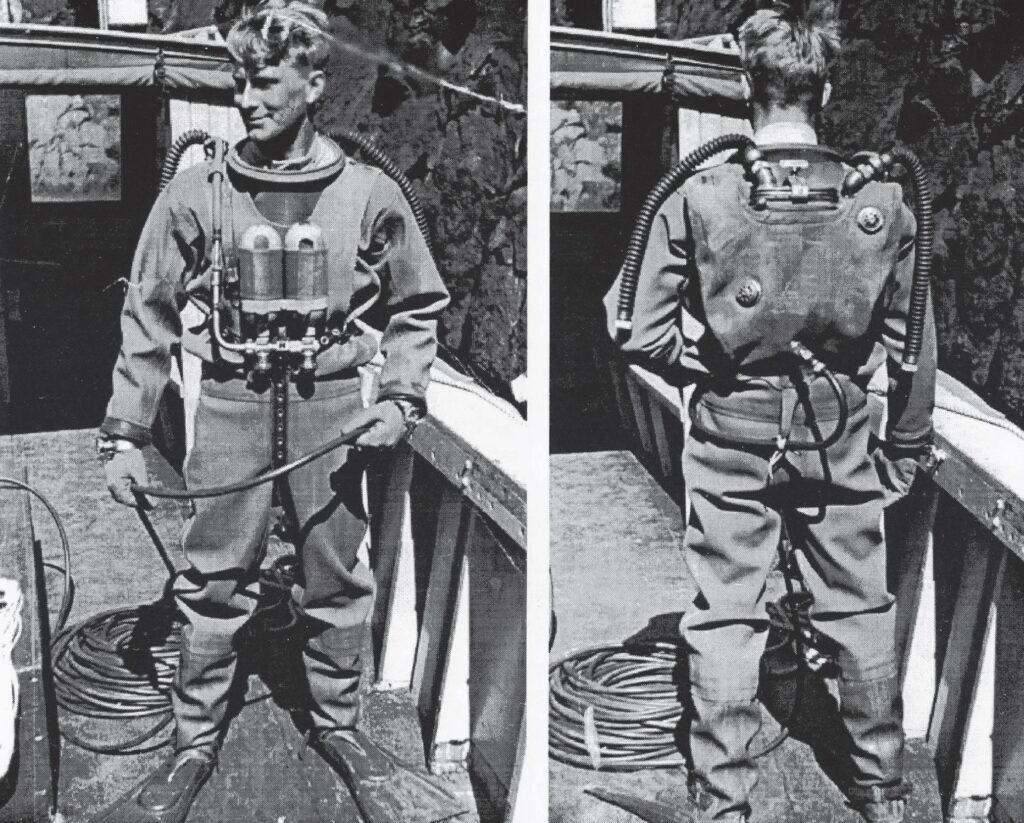
Photo 40: Ove Lund of hose supplied mixed gas device, for and rear view / © Source: Bjørn Bjørnø
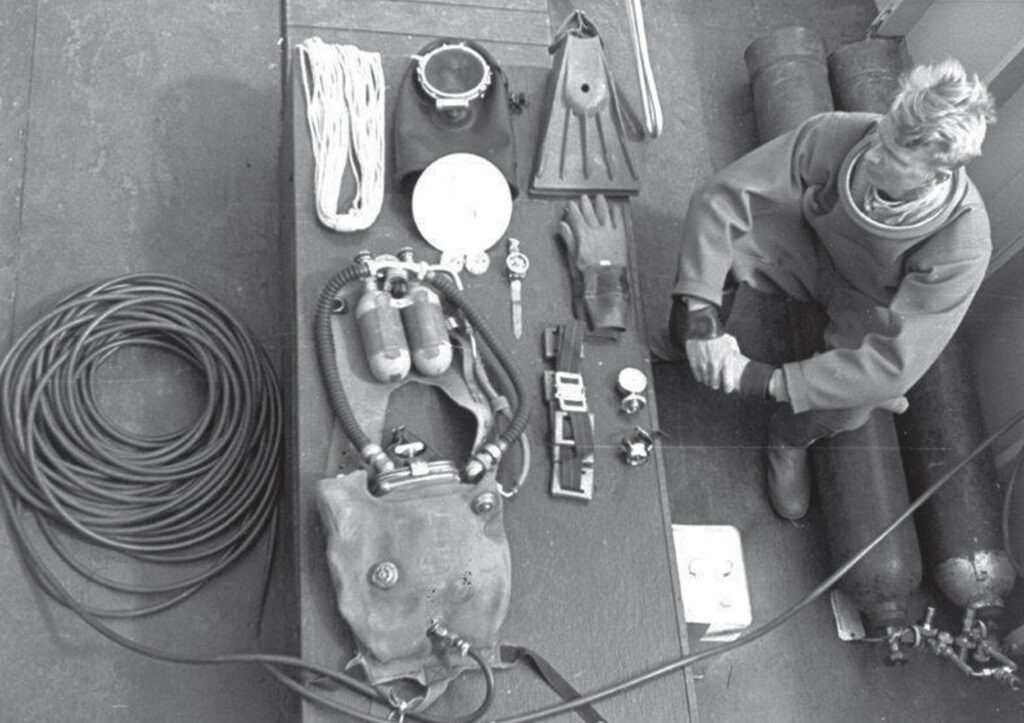
Photo 41: Ove Lund with hose supplied mixed gas device, existing out a in the series manufactured Dräger “Lieutenant Lund II” device and a compressed air supply hose, connected to compressed air (and oxygen?) from the cylinders on the surface.
/ © Source: Erik Birkeland , former “Sjef for norsk marines Dykker – og Fro – skemannskole” Norway
his ideas, a first surface independent mixed gas device, the “Lieutenant Lund III”. Lund was now enthusiastic and convinced of the possibility of diving to a depth of at least 100 meters with the correct dosage of oxygen and nitrogen, based on knowledge of diving physics and practical experience.
In the winter of 1955 he studied diving physiology and was heavily engaged in deep diving .
Based on his calculations he designed his own mixed gas and decompression table for “Oxygen and Air”. The round deco table with the name “Lt. cdr Lund’s decompr. computer” consisted of a 2-sided round rotating disc with a transparent disc showing a stripe on the front and back, with which the ratio of the breathing gas fraction and decompression times could be set and read. It extended to a maximum depth of 67 meters (Photos 42 and 43).
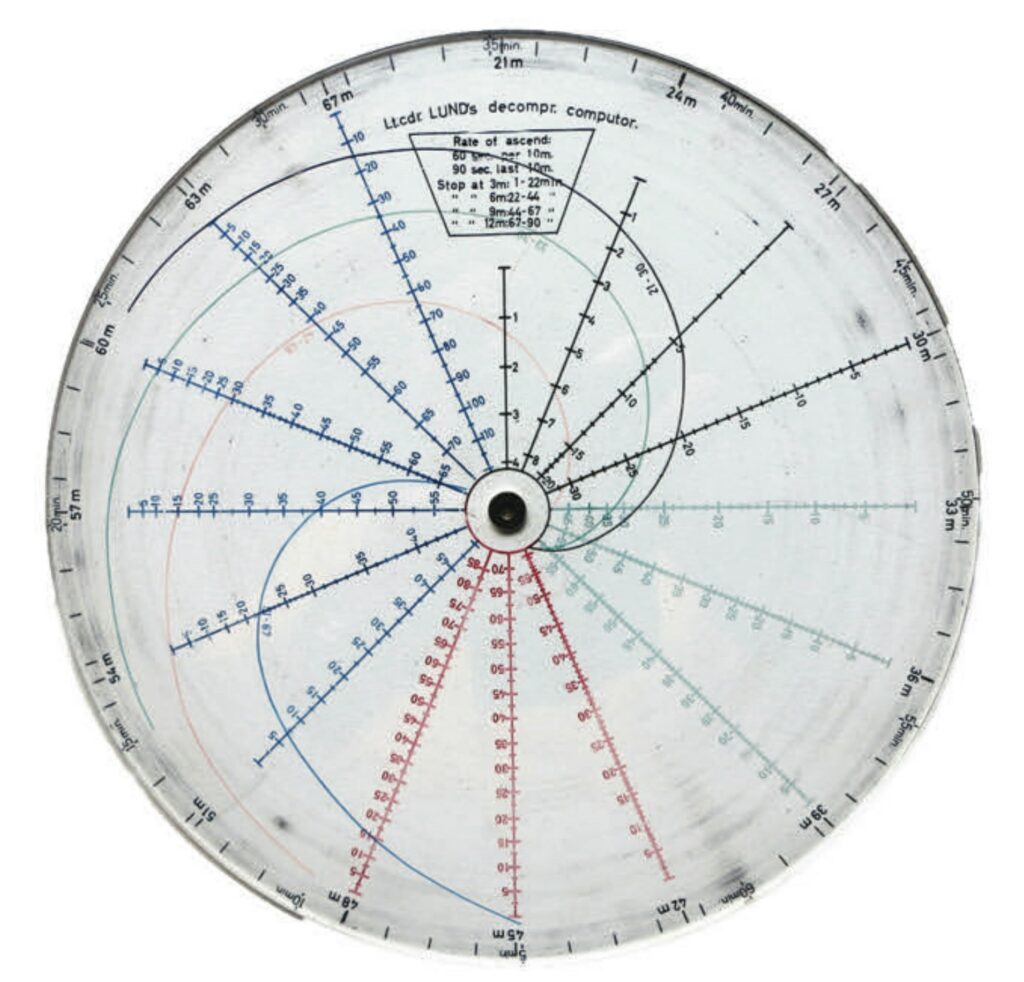
Photo 42: front “Lt.cdr. from LUND decompr . computers” / © source And Photo: Sven Erik Jørgensen
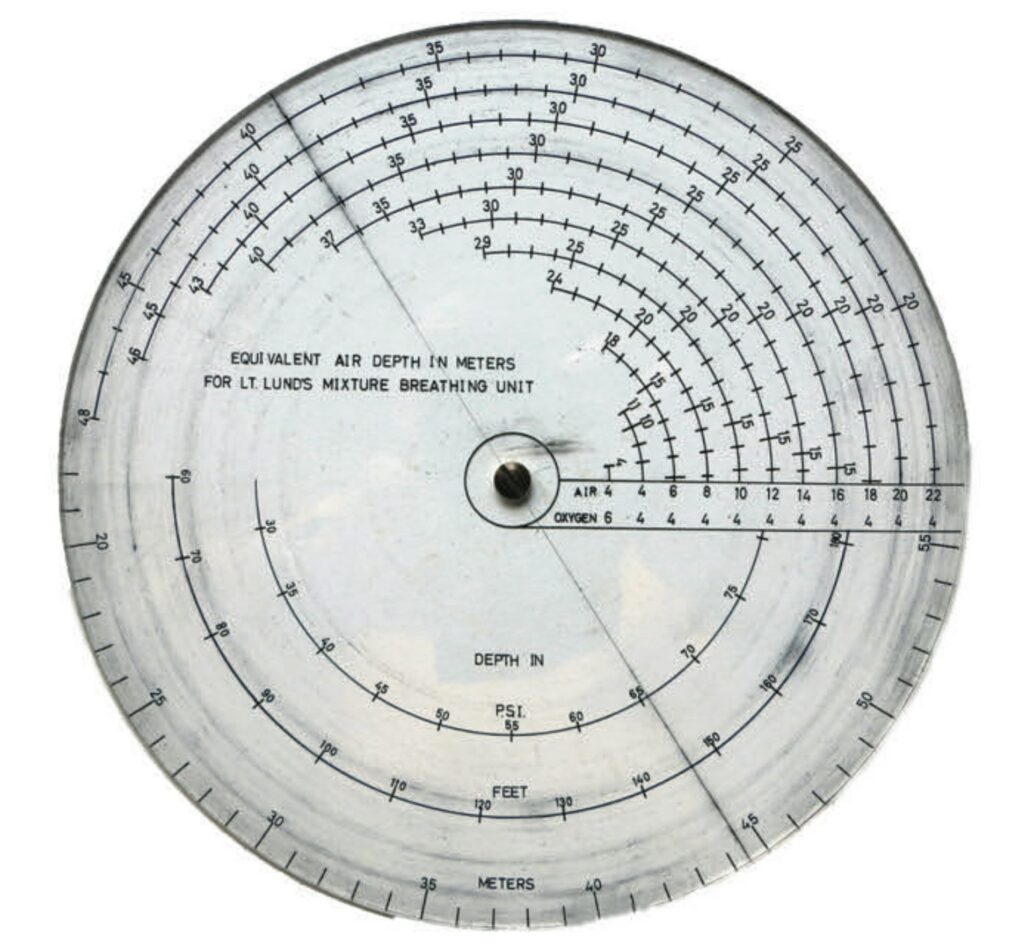
Photo 43: back “EQUIVALENT SKY DEPTH IN METERS FOR LT. LUNDS MIXTURE TO BREATHE unit”
/ © source And Photo: Sven Erik Jørgensen
The Dräger “Lieutenant Lund III” Oxygen Mixed Gas Swimming Diving Device
This semi-closed rebreather based on the closed Dräger “Lieutenant Lund II” was equipped with two additional pressure bottles of 5 liters each, mounted on a back harness in a position in front of the breathing lung. (photo 44). The few existing photos of this device show that an extra pressure relief valve is mounted in the breathing lung in the upper area on the right side.
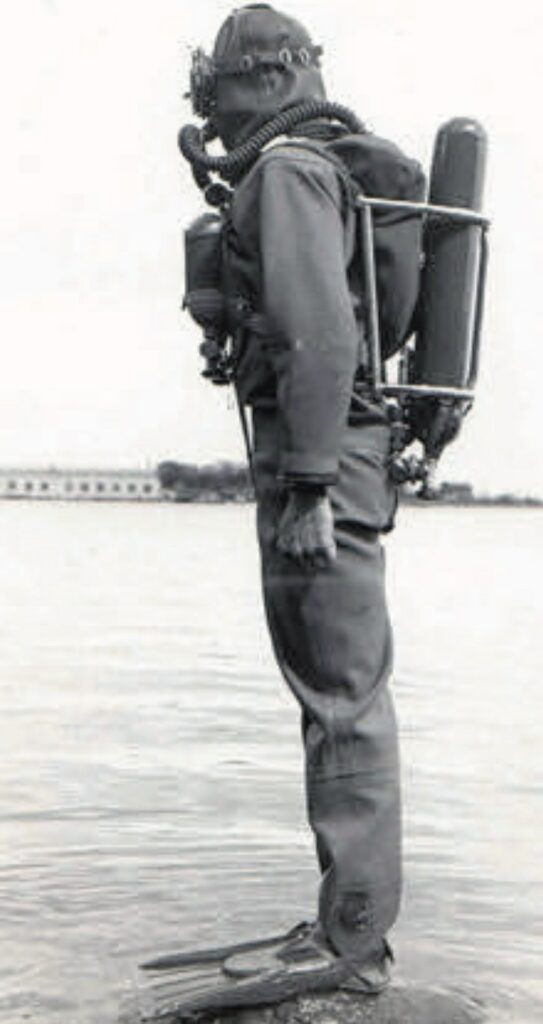
Photo 44.1/44.2: Dräger mixed gas gerät “Lieutenant Lund III”, © Source: Bjørn W. Kahrs BELOW
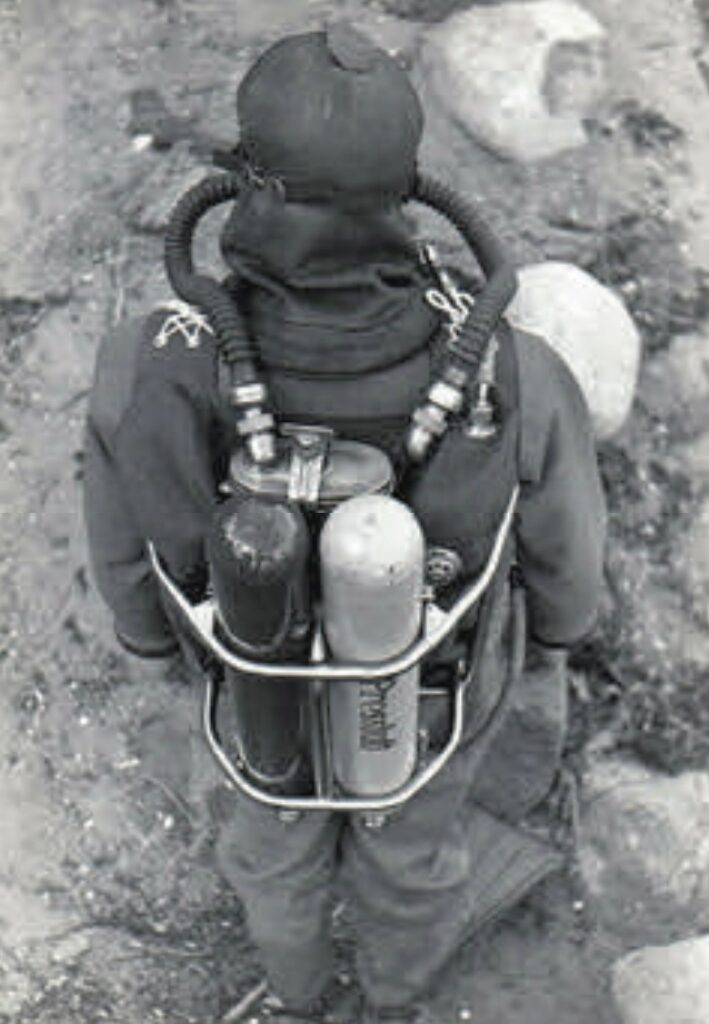
As with the hose-delivered mixed gas device described above, the standard pair of oxygen cylinders were mounted on the front of the vest. Nor the for the “Lund II” well-known pressure regulator with bypass function, nor a gas mixing valve, one searches in vain for in the photos. Also detailed photos or construction documents and descriptions have not yet surfaced for this device, officially known as the Dräger “Lieutenant Lund III”.
Fähnrich Børge Holm, a Danish student and observer of the diving school, reported [12] that the diving equipment used was relatively new and had not been used much by the diving school.
“It contains a compressed air bottle and an oxygen bottle, each with a pressure of 200 bar. Mixing takes place by means of nozzles and throttle valves in a certain ratio. Exhalation takes place in the respiratory lung.
So can man rest assured, that a “Mix gas valve with nozzles and throttle valves” were present!
The scrubber, inhalation and exhalation hoses with breathing valves attached to the device side, as well as also the respiratory lung corresponded to the “Lund II” series devices and became not altered.
The tragic Monday
On Monday, August 13, 1956, Lieutenant Ove Lund undertook a test dive with the new Lieutenant Lund III mixed gas diving apparatus, which had been developed in conjunction with Drägerwerke in Germany. He intended to dive to 90 m and, if successful, continue to dive to 100 m. His intention was to then return to 90 m, stay there for a maximum of 12 minutes, and then return to the surface according to self-calculated ascent times.
During this test dive, Lund suffered a fatal accident.
Lund wanted to make the test dive as soon as possible, because he wanted to bring the results to Dräger during his holiday and talk to Hermann Tietze about any necessary improvements.
On Saturday, August 11, 1956, he tested a similar device with a single mixed gas bottle (contents unknown together with the standard 2 bottles of each 0.8 liters of oxygen) in the pressure chamber. He dived to a depth of 90 meters without any problems.
Well prepared and with a selected crew, he planned the test dive for Sunday, August 12, 1956. Also the position of the dive site, ½ nautical mile to the north of Lövöya in the Oslofjord. [12]. There were two “demagnetizing boats” (minesweepers), about 35 feet (10.5 meters) long, with a top speed of 14 knots. He also had a motorboat at his disposal.
Unfortunately, the weather prevented the test dive on Sunday. The sea state was too strong.
So the dive was postponed to Monday, August 13, 1956.
“The four bottles of “Lieutenant Lund III” were all filled. Two 0.8 liter bottles and one 5 liter bottle contained pure oxygen with a pressure of 200 bar. The second 5 liter (Mix gas) cylinder contained 24.5 % oxygen and 75.5% % nitrogen [11] with a filling pressure of 208 bar, thus, 1320 litres of oxygen and 1040 litres of mixed gas (NITROX) were mathematically available.” The following is an extract and summary of the statements of all those involved in the events from the later report of the Commission of Inquiry [11]
Attendees team:
Thorleif Thomassen, dive leader and signalman _
Berg Flött Iversen, signalman
John Pedersen, 1. Standby Diver (Trainer)
Steinar Wickmann, 2. Standby Diver (Trainer)
Bjørn Bjørnø , assistant instructor
John Olsen , assistant instructor (friend and regular collaborator of Ove Lund)
Børge Holm , Danish marine, Pupils of the frogman school
Poul Jarlskov , Danish marine, Pupils of the frogman school
Of the naval command Ostlandet :
dr Etholm , ward physician together with some teaching assistants
From one of the two minesweepers, a 25 kg plumb bob attached to a bottom line was lowered – to a depth of 100 m – not quite to the bottom, which was 110 m deep. The bottom plumb line contained a light source pointing upwards.
It was agreed before the dive that Lund would descend to the planned depth, remain for 12 minutes, and then, according to the decompression table, be stopped for breaks during the return to the surface, even if for some unforeseen reason he was unable to make the ascent on his own. The further agreement was that if they lost signal connection, Lund would halve the planned bottom time of 12 minutes and then immediately begin the ascent.
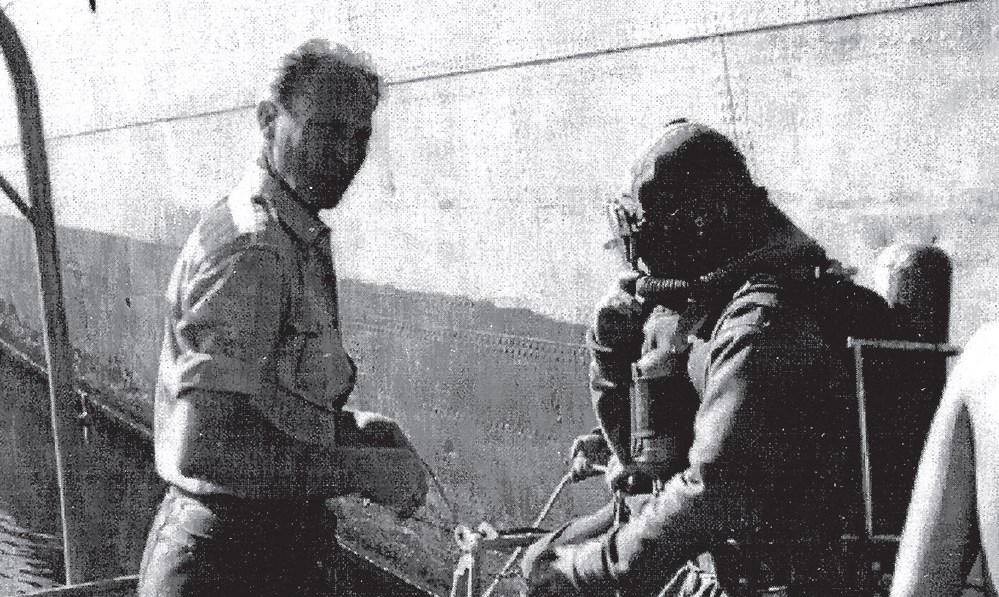
Photo 45: Dive leader and signalman Thorleif Thomassen and Dräger mixed gas device “Lieutenant Lund III” (Photo from previous dive attempt) / © Source: Bjørn Bjørnø
11:31 am, Captain Lieutenant Lund begins the dive (photo 45).
On the bottom line, Lund descended with the new mixed gas device Dräger “Lieutenant Lund III”, with a “Dräger constant volume suit” and a signal line. He initially had problems with the pressure, resurfacing four times before finally descending completely at 11:35 am.
Dive leader Thorleif Thomassen, with Berg Flött Iversen on board, operated the signal lines to Ove Lund, as well as to the signal operator Børge Holm, who dived shortly afterwards.
Due to the swell, it was not entirely certain that the signals through the line would not be lost until the target depth was reached. So, in view of the possibility of signal loss, it was decided to station an observer and signal communicator at a depth of 50 m. It was the Danish midshipman Børge Holm who filled this position.
11:40 am, Signalman Børge Holm is positioned.
He went down as agreed with compressed air equipment and his own signal line and positioned himself next to the bottom line and Lund’s signal line at 50 m depth.
In order to clearly feel and transmit the signals from Lund to Thomassen and back, Holm (this is the literal translation) clamped “Lund’s signal line in his armpit”. When Lund passed 70 meters from the signal line, his signals were very weak, as suspected before the test dive.
11:42 am, signal for ascend not answered.
The agreed bottom time was almost up. A signal from Holm to Lund was not answered. So Holm gave 4 pulls up with his own line to signal Lund to come up.
With Lund still not responding, they began to carefully roll up Lund’s signal line in the agreed manner, which was very difficult. The signal line snapped about 10 m below the surface of the water. It was not intended or suitable for lifting the weight that was now hanging on it (Lund plus ground lead – which was not known at the time). The signal line, which was under tension, snapped with a jerk, possibly also as a result of the now increased swell. At a depth of 50 m, Børge Holm held the rest of Lund’s signal line.
It soon became clear on board that something was wrong.
11:44 am, 1st reserve diver John Pedersen is sent down by the dive leader with his scuba diving equipment.
He dives without a signal line, as instructed by Lund. Lund didn’t want too many signal lines in the water at once. Pedersen encounters Holm at 50 meters depth. They manage to hold the rest of Lund’s signal line and tether to the bottom line at this depth.
This way the signals can still be passed on to Lund and Lund cannot sink any further in case there have been problems, unaware that Lund has already lost consciousness at this point.
The 1st reserve diver Pedersen dives further along the bottom line and finds Lund upside down at a depth of 80 meters entangled in his own signal line and bottom line.
Lund is motionless but has a pulse. The mouthpiece is still in his mouth. His eyelids move a little, he exhales slightly. The respiratory lung is inflated. Pedersen stands him up and tries to resuscitate him by forcefully squeezing his chest again and again. He cuts Lund out of his line entanglement and begins the ascent with him while continuing to try to resuscitate him.
Note: It has been suggested that the first reserve diver, John Pedersen, had additional problems with his own signal line below. However, this is contradicted by the Commission’s report. Witness Steinar Wickmann, 2nd reserve diver, answered the Commission’s question: “Did Pedersen use or own his own line?” Wickmann’s answer: “No”.
At about 60 m, Pedersen regularly noticed small movements in Lund’s breathing lung. At the same time, he momentarily opened his eyelids. Pedersen was under the impression that Lund saw him. It seemed as if he wanted to give a sign with his hand while he moved a little. However, he stated that maybe Lund’s arm was just swinging in the water stream. Pedersen continued to ascend with Lund to 50 m.
11:54 am, 2nd reserve diver Steinar Wickmann is sent down to help
After successfully resolving mask fogging problems at a depth of about 20 m, he met John Pedersen at 50 m, who, along with Lund was on the way up. Wickmann also dived with compressed air and without a signal line.
They spent about 4 minutes at this depth. They added oxygen from the chest cylinders to Lund’s breathing circuit to increase buoyancy, but it spontaneously escaped again through the pressure relief valve of the constant volume suit.
At 40 meters they saw that he no longer had the mouthpiece in his mouth and the breathing bag had deflated.
During the further ascent at about 35-30 meters Lund had a sudden attack in his arms and legs. He twisted at a right angle from the waist up. However, the attack was over in a few seconds, followed by red foam from the mouth area. The further ascent went slowly but without decompression pause to the surface.
12:03, Pedersen and Wickmann surface with Lund.
Lund was immediately taken aboard by dive leader Thomassen on arrival at the surface and the mask glass was opened, spontaneously revealing a copious discharge of bloody foam from the mask and mouth. His body was relaxed. The pulse rate was 45-50 beats per minute with unnoticeable breathing.
Dr. Etholm now took over the artificial respiration.
12:12 PM, cardiac arrest
Dr. Etholm reported to the committee that at 12:12 Lund had no pulse.
At top speed, Lund was taken to the pressure chamber at the naval base in one of the boats.
(Photos 31 and 32) [12], where he was subjected to recompression starting with 5 bar overpressure. This was done by Dr. Etholm with associated resuscitation attempts.
Before departure, Dr. Etholm assistant instructor Bjørn Bjørnø to ensure that Holm, Pedersen and Wickmann were recompressed by descending immediately.
14:05 pm, cessation of CPR
Despite approximately 2 hours of CPR attempts in the pressure chamber and continuous supportive medication, clear signs of death were noted as of 2:05 PM. Dr. Hovig, the ship’s regular doctor, also arrived a few minutes later and upon examination confirmed that Lund was dead.
The cause of death
A preliminary assessment of the cause of death quickly concluded that a mixture of oxygen toxicity and nitrogen narcosis followed by decompression sickness resulting from the direct ascent was responsible for Lund’s death.
Captain Lieutenant Ove Lund, the first head of Norway’s Navy Frogman School, died in an accident at the age of 32. He was famous in Norway. The public and the press took great interest in his accident.
“Aftenposten” reported about it on the front page of August 14, 1956, the day after the accident (Photo 46).
The paper went on to write: “Ove Lund never left anything to chance. He impressed the students by preparing them for diving with the utmost care. It is indicative of his attitude that he was strong enough to take the free and uncontrolled sale of diving equipment in the (lay) trade. He was a leader in the true sense of the word”.
The Chief of the Navy, Vice Admiral Johs. E. Jacobsen, comments to Lieutenant-Captain Lund in “Aftenposten” as follows:
“Ove Lund had already established a reputation as one of the world’s foremost frogmen. The news of his death will be noted with sadness both in our own navy and among those around the world interested in diving with frogman gear.”
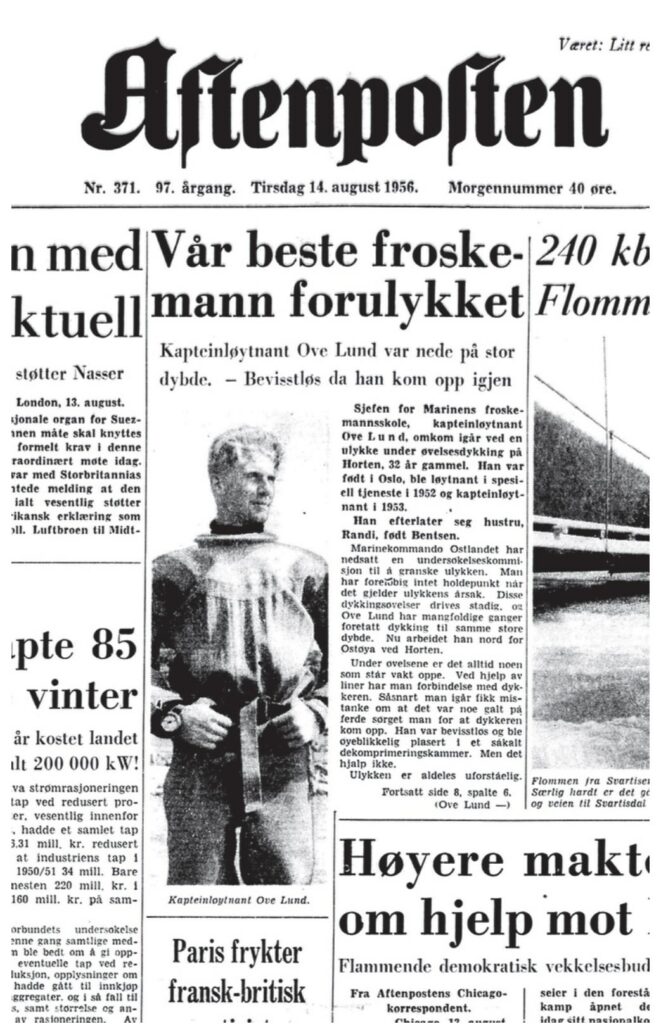
Photo 46: “Our best frogman has died”: “Captain Lieutenant Ove Lund was at a great depth.
– Not suspecting that he would not surface alive” / Source: Aftenposten, Oslo
To research to the cause of the accident
The diving equipment involved in the accident was immediately shut down. It was then sent to the Respirasjonsfysiologisk Oslo-Service for examination as a “Dräger light diving device type Lund III”.
“Respirasjonsphysiologisk Oslo-Service” and returned to Horten a day later. Bjørn W. Kahrs [1], who discovered this and who luckily obtained a lot of information about Ove Lund, has still not been able to find the whereabouts of the device or an investigation report.
The proof is that the preparations and safety measures were fully discussed between Dr. Etholm and Lund. Etholm explained his personal view of things and discussed it with Lund before the experiment. He also made him aware that it was risky to dive to a depth of 90 to 100 meters with this device, with which he had so little experience. Ove Lund, however, was convinced that he had calculated everything correctly.
Before the dive, on the morning of August 13, 1956, Ove Lund walked to the boats with Danish diver Poul Jarlskov. Jarlskov asked him what gases were in the two extra 5-litre cylinders. “Is it pure nitrogen or a mixture?” Lund put his hand on Jarlskov’s shoulder and said with a smile, “Poul, I’ll explain everything when I come up again” [14].
Which breathing gas did the second extra bottle contain?
Did Lund dive with helium?
As the witness John Olsen later confirmed before the investigative committee, the 5-litre auxiliary cylinder filled at 208 bar contained an oxygen content of 24.5%. Was the rest really nitrogen?
Sven Eric Jørgensen writes in his article [14] that it was not logical to “use a gas with
≈25% oxygen and ≈75% nitrogen, instead of atmospheric air with 21% and 79% nitrogen” and proposes the obvious question: “Dykkede Lund med helium?”. – Did Lund dive with helium?
Jørgensen’s article is based on the assumption that the Dräger “Lieutenant Lund III” with its “mixed gas valve with nozzles and restrictions” described by Børge Holm may have been the prototype of a Dräger “Heliox” device. He refers to two Dräger patents that later led to the autonomous self-mixing deep-diving device Dräger “Model SM III”.
In the early 1950s Hermann Tietze, chief engineer at Dräger, continued the development of the Heliox deep-sea diving device, which he had already started in the 1940s. An “independent diving apparatus with oxygen and inert gas supply from separate storage cylinders and carbon dioxide adjustment, especially for great depths” was registered by him as a patent in 1955 (DE1137645). [15]
As with the device patented as far back as 1943, the volume fraction of helium in the breathing mixture increased with increasing depth. In this system, an automatic double-diaphragm pressure regulator opened up the volume portion of the helium supply, while the solid supply of oxygen remained the same for each depth.
Experimental Heliox equipment was thus available from Dräger, as was helium as an inert gas (which was imported from the US at the time and hardly available in Europe). The possibility that Lund made use of this new construction cannot therefore be completely ruled out.
But – as already described – neither an example of the mixed gas device “Lieutenant Lund III” nor its construction documents have been found so far. The function of a “mixed gas valve with nozzles and restrictions” remains a mystery.
Dive doctors, military and professional divers, diving historians and recreational divers are still debating the unexplained causes of the accident. In the end, most of them came to the conclusion that Ove Lund did not dive with HELIOX, but with NITROX.
This is difficult to understand, because it was known and tested long before Lund’s experiment that the depth limit for diving with mixed gas, consisting of oxygen and nitrogen, is about 60 meters.
The Commission of Inquiry concludes: “that his comrade Thorleif Thomassen was very concerned about Lund and felt that the exercise was too risky. There is also no doubt that the conscientious Captain Lieutenant Lund himself was of this opinion. But he had an enthusiastic well-founded feeling of self-esteem because the future of the community was at stake and how far as an enthusiastic pioneer he could go with his personal effort to passionately contribute to the betterment of respiratory systems”.
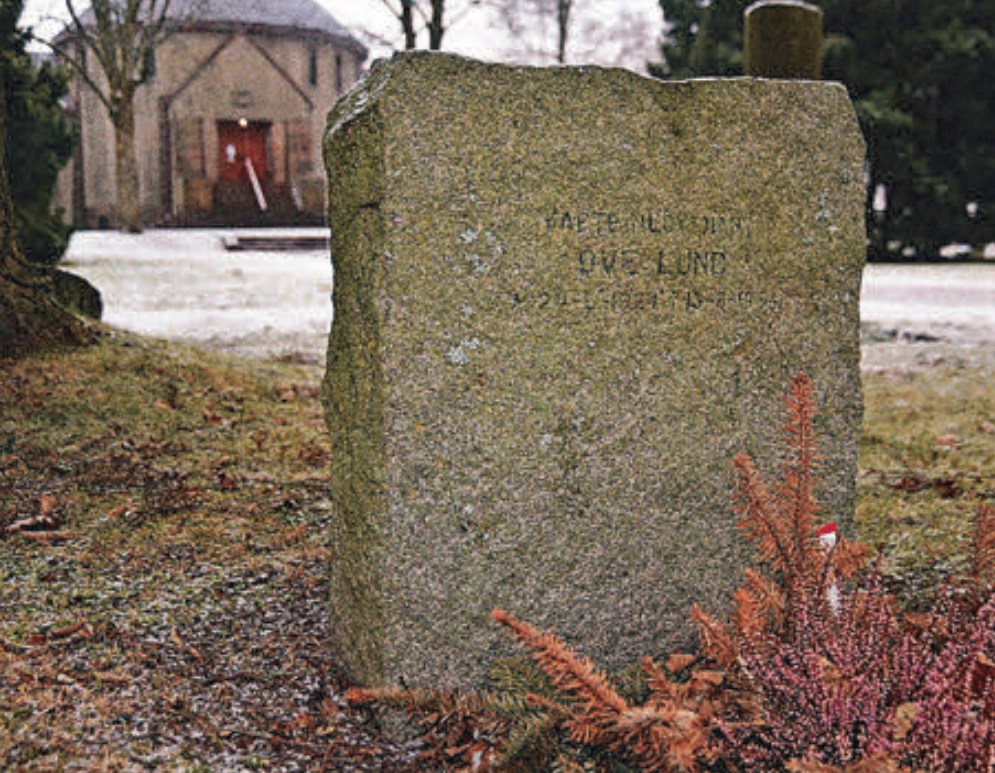
Photo 47 Lieutenant Captain Ove Lund’s tombstone to the Cemetery Vestre Gravlund”, Oslo
/ © Photo: Børre A Børretzen shorts , Source: Bjørn Kahrs
Randi and Ove Lund remained childless. Randi later remarried.
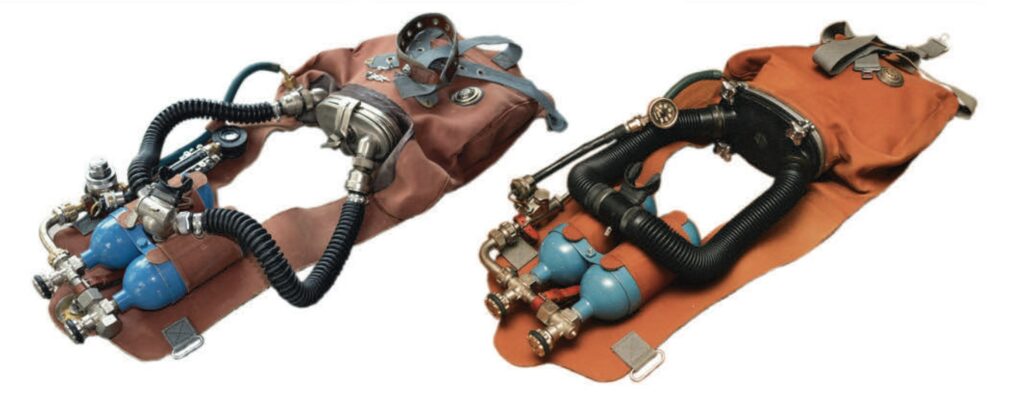
Figure 48: Comparison of Dräger “Leutnant Lund II” and Dräger “NORGE I”. (Device “NORGE I” here with an atypical
pressure gauge connection. The standard device was equipped with a pressure gauge directly on the pressure regulator)
left Device: Dräger “Lieutenant Lund II” / © Photo: Helmut Knüfermann
right Device: Dräger “NORGE I” / © Photo: JW Bech, NL, with friendly permission
Drägerwerke owes much of the development of the first oxygen breathing apparatus for military use in the early 1950’s to the highly dedicated Norwegian naval officer Lieutenant Lund. Therefore, the development of these devices is also closely linked to the cooperation of the Norwegian Navy and the establishment of the first “Norwegian Frog School”. [16].
See also in the appendix (Appendix 1), the graphic representation of the Dräger diving equipment used by the “SJØFORSVARETS DYKKER- OG FROSKEMANNSSKOLE” since the “SJØFORSVARETS DYKKER- OG FROSKEMANNSSKOLE” [16].
used by the “SJØFORSVARETS DYKKER- OG FROSKEMANNSSKOLE” since its foundation.
The tragic accident in which Lieutenant Captain Lund died while attempting to dive off the Norwegian coast did not halt the development of the projects he had started with Drägerwerke. The Royal Norwegian Navy continued its cooperation with Dräger.
The Oxygen diving device “NORGE I” (Dräger drawing no.: T10200)
For example, from 1957, at the request of the Norwegian Navy, Dräger produced a modified version of the successful “Lieutenant Lund II”, which continued to be produced at the same time,
Gerhard Haux, an engineer in Department II of the Drägerwerk, developed the “NORGE” oxygen diving device [16]. The design of the “Westen” was similar to that of the “Leutnant Lund”. The oxygen supply also remained the same with a pair of 2 x 0.8 liter cylinders and a filling pressure of 200 bar. The same applies to the constant dosing with 0.9 l/min O2 and the possibility to add O2 via the bypass valve. The device also incorporated the pressure relief valve in the breathing bag developed by Gerhard Haux, set to a blow-off pressure of 15-16 cm WS.
However, the device had the following changes:
– an enlarged scrubber with a net capacity of 3.8 liters with four locking hand screws for the lid, instead of the previous one with one locking clamp.
– the flow cross-sections of the new breathing tubes have been increased by approximately 60%.
– Correspondingly enlarged flow cross-sections of the control valves in a new aluminum rotary slide nozzle
– the pressure gauge is attached directly to the pressure reducer and cannot be folded
– a modified, simplified and slightly enlarged breathing lung without bulges at the shoulder section with a movable volume of 9-10 litres. See comparison (Figure 48)
These adjustments resulted in a reduction in breathing resistance with a simultaneous increase in CO2 absorption capacity. The lower flow rate in the large lime pattern led to more effective contact of the breathing gas with the soda lime and prevented too little CO2 absorption, even at very high flow rates.
The Oxygen diving device “NORGE II” (Dräger drawing no.: T5650)
The “NORGE I” and the oxygen recirculation units of the type described above were made of red-brown robust cotton fabric, partly lined with rubber on the inside. However, the material was very stressed by frequent use and was sensitive to abrasion. Drying these recirculators was time consuming.
In cooperation with the Norwegian Navy, it was decided to replace this material with a strong, fabric-reinforced rubber cloth. One of the well-known manufacturers of technical rubber at the time, the company “Viking Stavanger A/S” in Norway, supplied the black fabric coated on both sides with a natural neoprene rubber, as requested by Dräger in 1959.
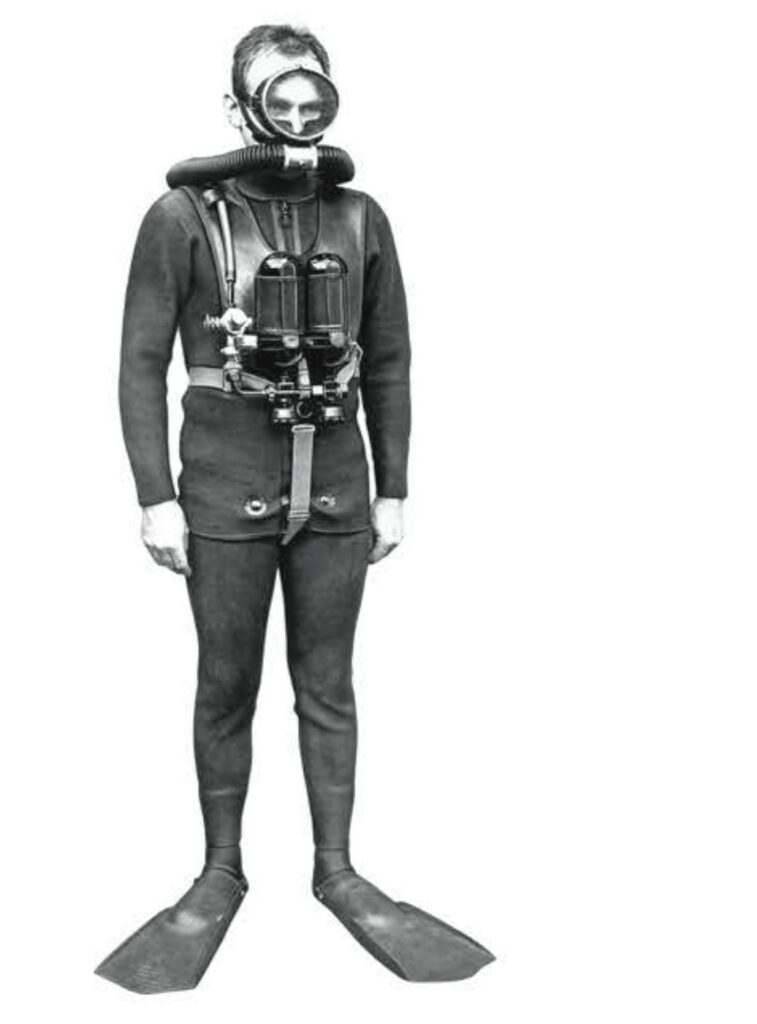
Photo 49: Dräger “NORGE II”. Factory photo: November 1968 / © Dräger Archive, photo: HK
The result was the “NORGE II”, technically completely identical to the “NORGE I”, but in an almost completely black design, including the oxygen cylinders (Fig. 49 and 50).
After a few examples of the vest were produced by “Viking”, further production was carried out exclusively by the Dräger company. A production tradition that, incidentally, applied to almost all Dräger products. This also marked the beginning of production of the Dräger “NORGE II” from 1960, which replaced the “NORGE I”. The “NORGE II” continued to be produced until the early 1970s – but in much smaller numbers than the original model of this type of diving device, the “Lieutenant Lund II”. The Norwegian Navy was not the only customer for Dräger NORGE aircraft. The Swedish and Danish Navy also used this type of rebreather in their units.
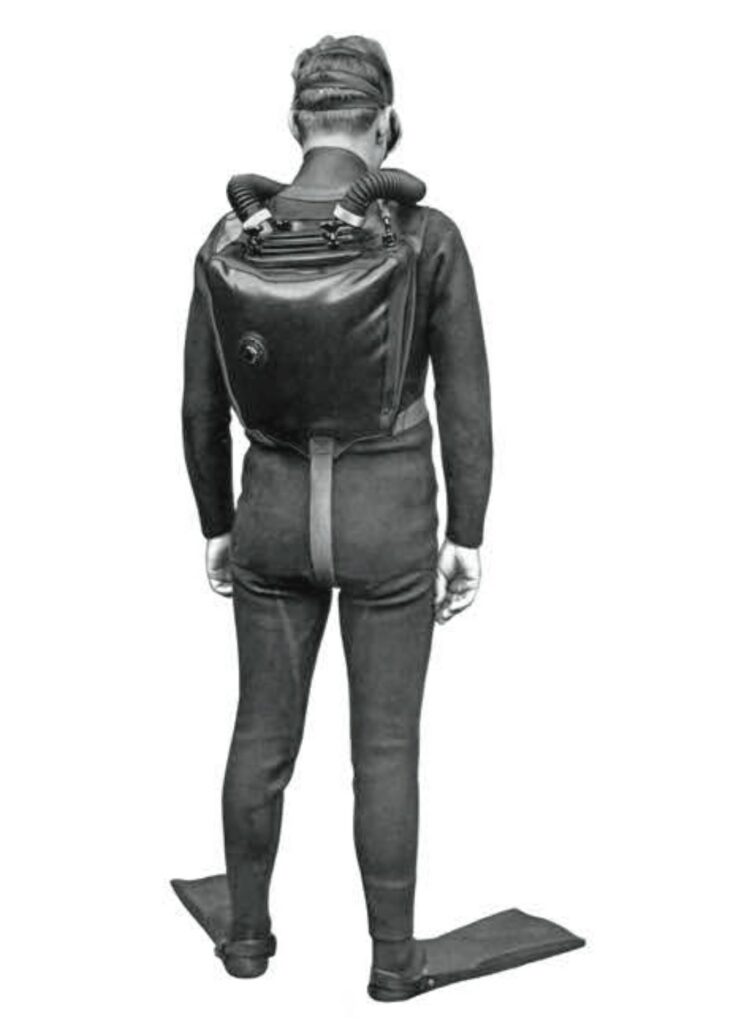
Photo 50: Dräger “NORGE II”. Factory photo: November 1968 / © Dräger Archive, photo: HK
The Oxygen swimming diving device “Model 600”
(Dräger drawing no.: T5421)
In April 1965, the technical department II of the Drägerwerk designed the “Model 600” according to the specifications of military customers (Fig. 51). Presumably the Norwegian Navy was again the initiator of this model, a modified version of the Dräger “NORGE I” with 2 O2 cylinders of 1.5 liters each with a filling pressure of 200 bar, which corresponds to 600 liters of oxygen supply as breathing gas. According to the instructions for use, this allowed a runtime or dive time of 180 minutes, which could be significantly extended by economical use with only light loads under water. Despite the lighter aluminum oxygen cylinders used here for the first time for this type of device, it weighed
“Model 600” just under 20 kg. Less important underwater.
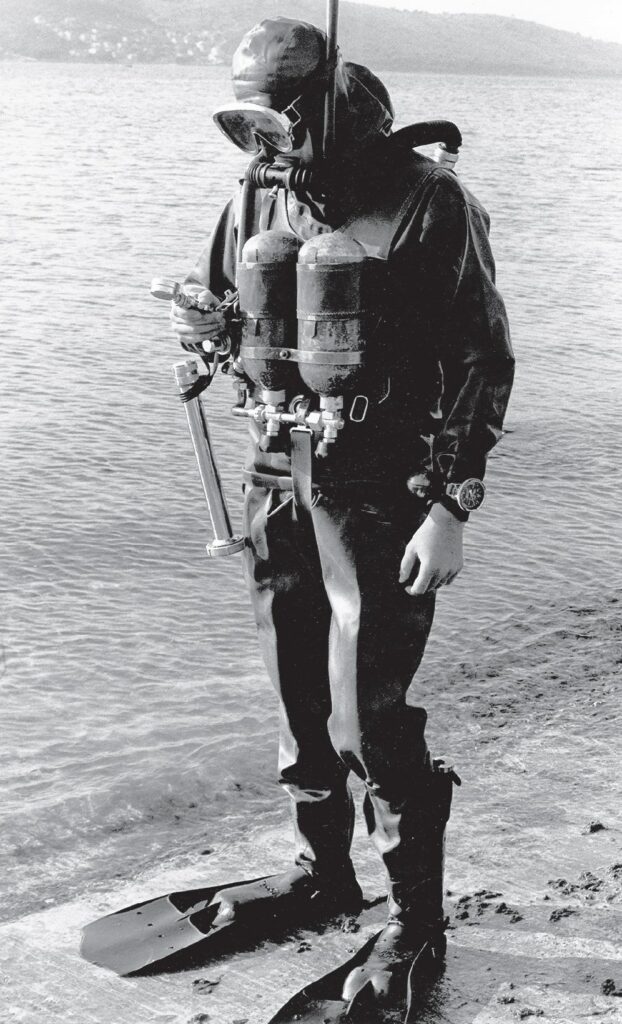
Photo 51: Dräger “Model 600” in use in the late 1960’s / © archive photo: Franjo Zeliak
However, compared to the weight of the “Lieutenant Lund” of about 13 kg and the “NORGE” of about 15 kg, it was a “sporting challenge” for combat swimmers who also had to wear weight belts and other tactical equipment above water.
The large scrubber and the larger breathing tube diameters with the correspondingly dimensioned flow cross-sections of the control valves of the “NORGE I” were retained here. All other parts were also identical to the “NORGE I”. Only the hinged pressure gauge for checking the cylinder filling pressure was adopted from the “Lieutenant Lund II”, unlike the “NORGE I”.
From 1954 to the mid-1960s, Drägerwerke built the oxygen recirculation unit “Lieutenant Lund II” for many naval units worldwide (figures 53, 54, 55, 56). A huge success for that time.
But already at the end of 1959, Division II of the Drägerwerk – also at the insistence of the German Navy – started developing the first prototypes of a “Lung Automaten Regeneration gerätes” “LAR” in the “hard-shell” design that was placed on the chest. worn, which in the following years led to the replacement of the legendary “Leutnant Lund II”, the “NORGE I” and “NORGE I” ,as well as the “Model 600”.
“Lieutenant Ove Lund (Fig. 52) would certainly have inspired this new development with his ideas. He deserves a special place in diving history. He will remain unforgotten.
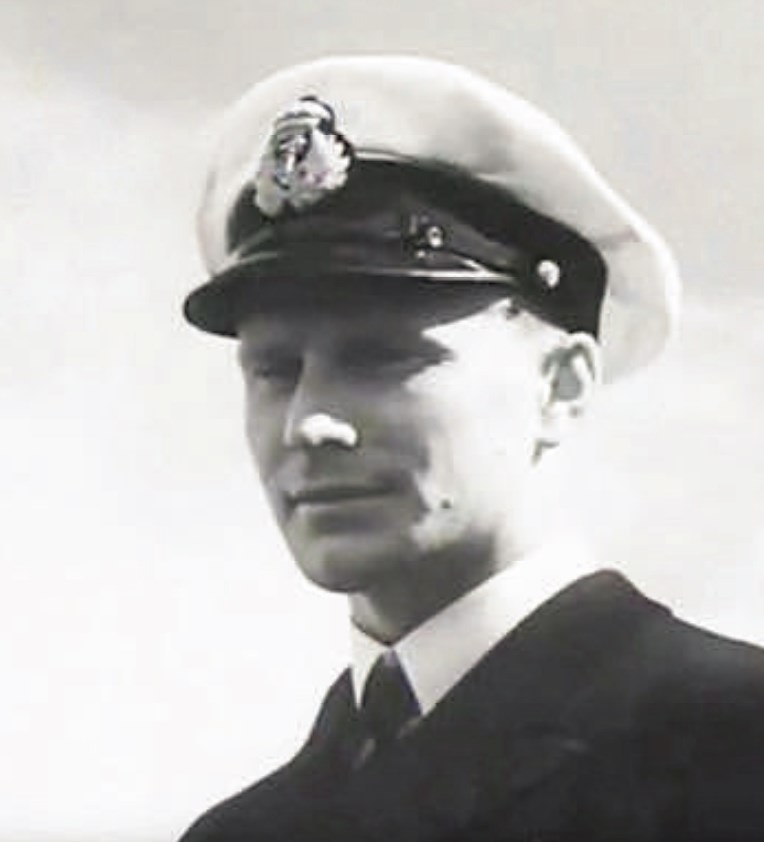
Figure 52: Lieutenant Captain Ove Lund
/ Source: Freeze frame off the movie documentation ” Fryktlose frog men on Boerne. 1953″ © Tbgfilm.com
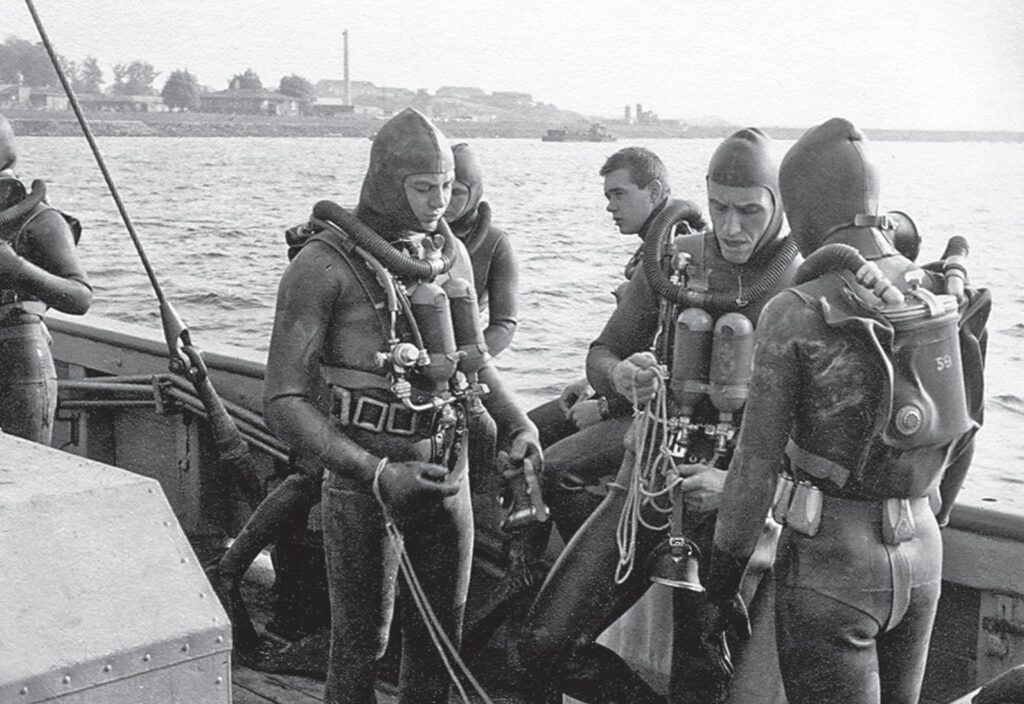
Photo 53: Kampfschwimmer of the Federal German Navy with the Dräger “Lieutenant Lund II” in the Year 1962 / Source: © Winfried Achtert, former combat swimmer in the German Navy
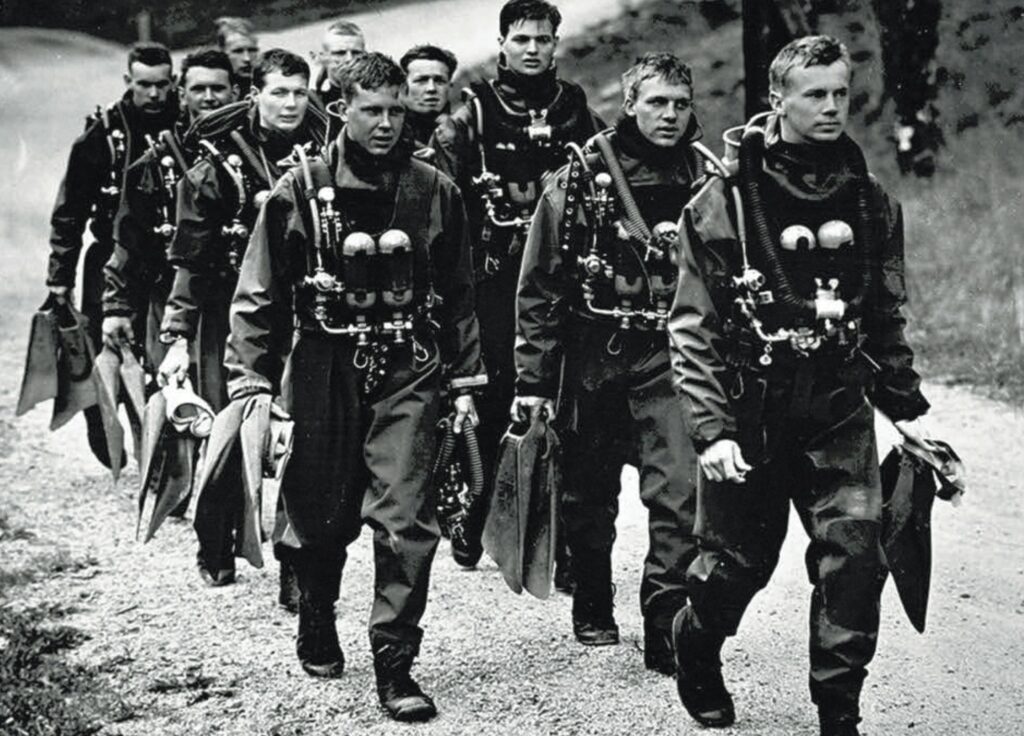
Photo 54: Frogmen of the Swedish “Kustjägarna” on their way back from training with the Dräger “Lieutenant Lund II” in April 1961 (except for the first man on the right and the third man on the rear right, they carry a Dräger “NORGE II” oxygen-rebreather ) / Source: © Wictor Phalėn , Sweden
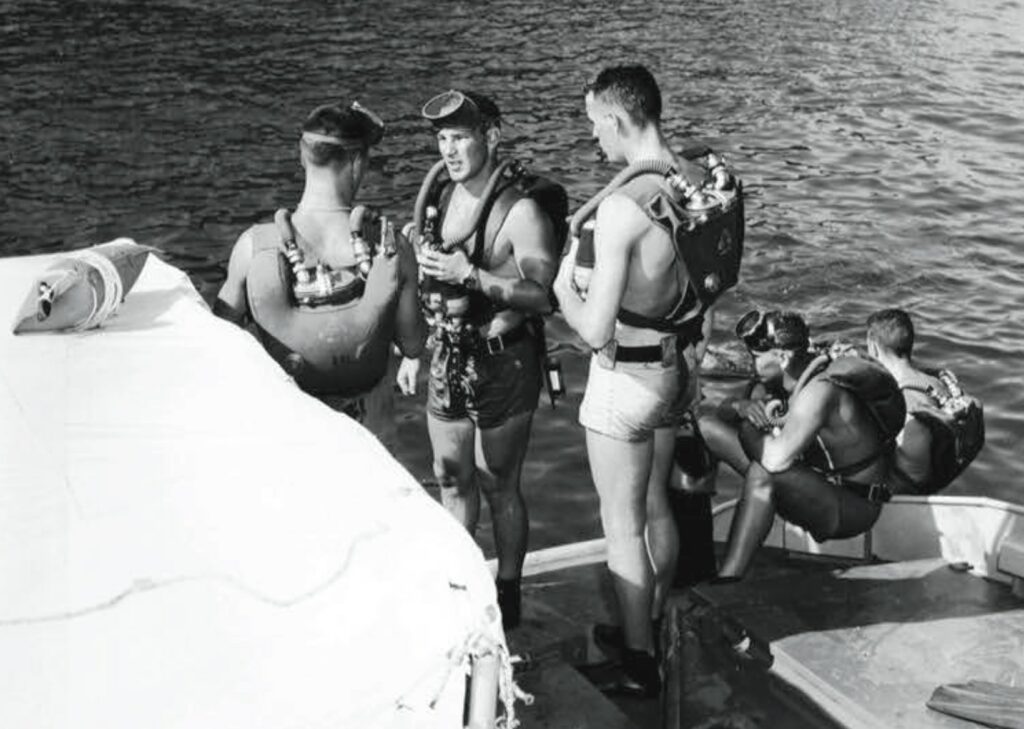
Photo 55: battle swimmer the “UDT” (Underwater Demolition Team), United States Navy,
with the Dräger “Lieutenant Lund II” in the 1950’s
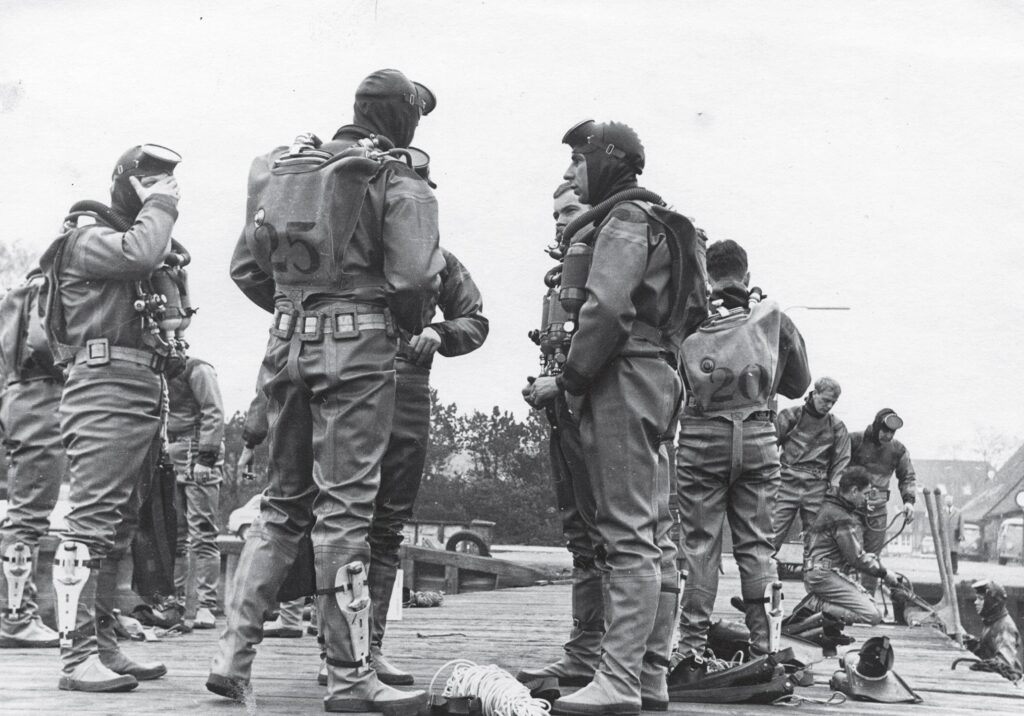
Photo 56: Dansk „Frømandskorps“ kurs på Naval Base Holmen in 1966 med „Leutnant Lund II“ dykkerudstyr / Foto:
© Edin Rasmussen, Quelle: Sven Erik Jørgensen, Danmark
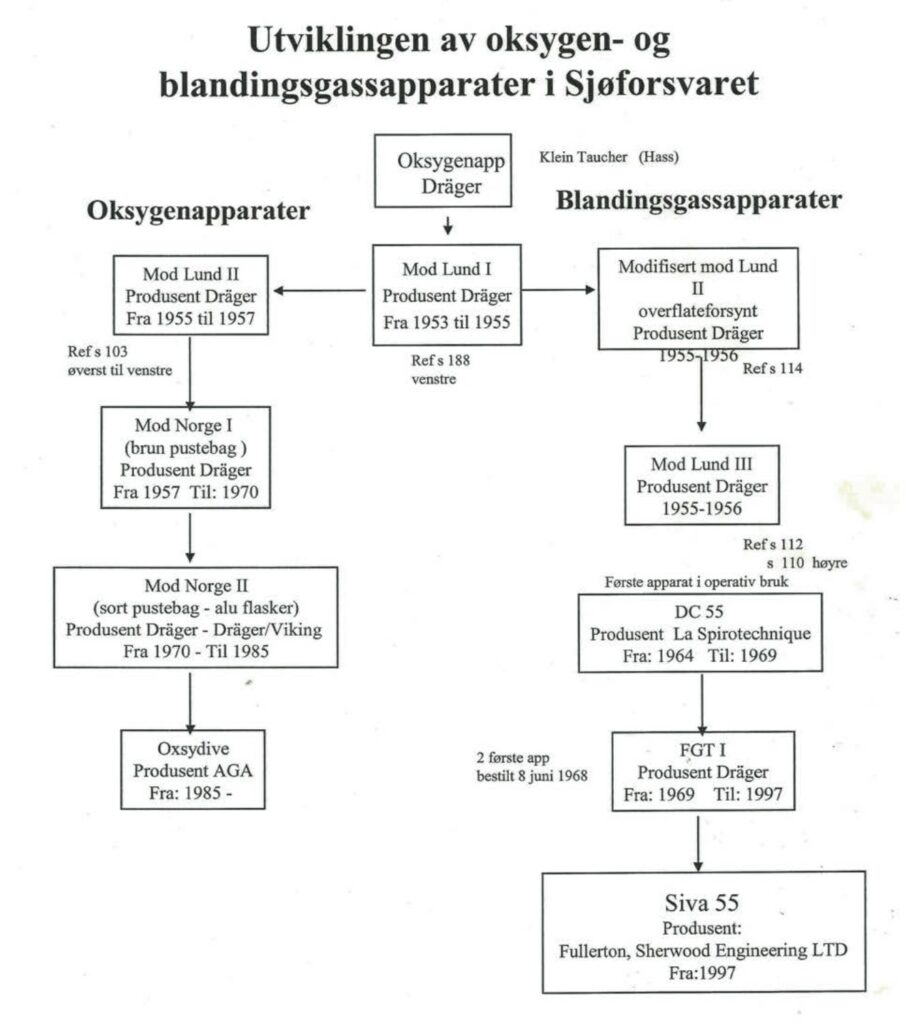
Appendix 1.1: Description of the diving equipment used by “SJØFORSVARETS DYKKER- OG FROSKEMANNSKOLEN”, Norway, since its establishment until 1997 / Source: Erik Birkeland, “Sjef for norsk marines Dykker – ob Froskemannskolen” 1989 to 1990
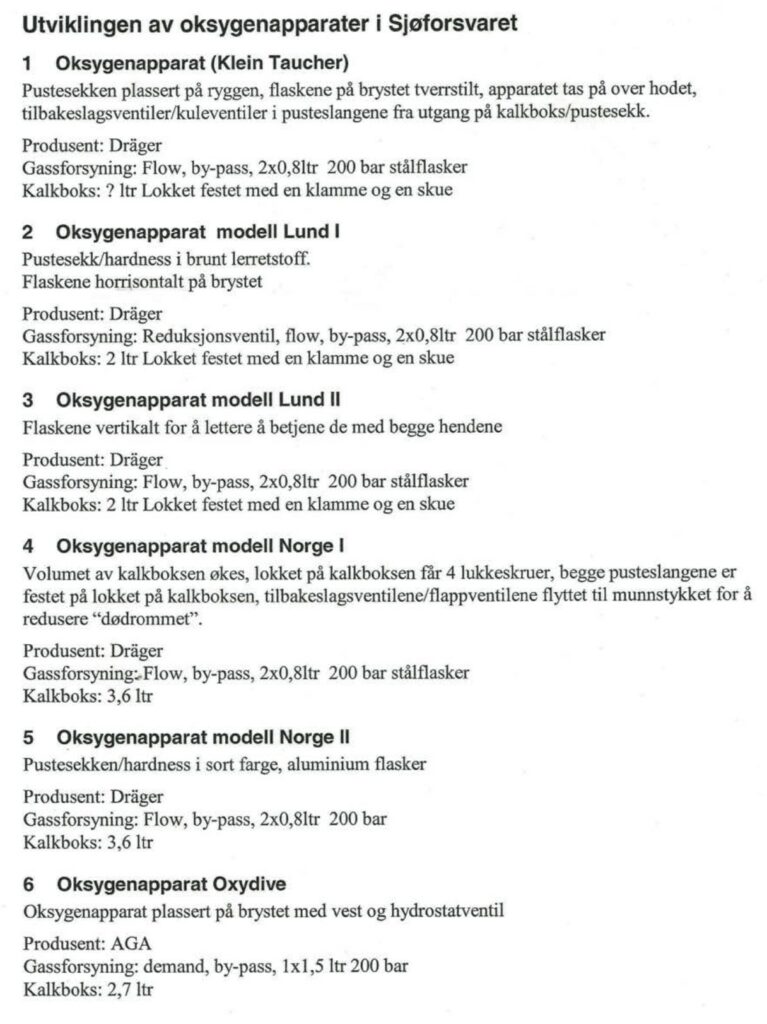
Annex 1.2: Description of the diving equipment used by “SJØFORSVARETS DYKKER- OG FROSKEMANNSKOLEN”, Norway, since its establishment until 1997 / Source: Erik Birkeland, “Sjef for norsk marines Dykker – og Froskemannskolen” 1989 to 1990

Table 1: Table the by the Drägerwerke manufactured Diving equipment with oxygen circuit for the military use in “West” design
Endnotes and references
[1] Bjørn W. Kahrs, instructor at “Comex Diving”, diving guide for pressure chamber systems, offshore diver, studied history, former president of the Norwegian Baromedisinsk Association and the Norwegian Society of Diving History and diving historian. Kahrs, BW: “Kapteinløytnant Ove Lund. Første sjef for Marinens Froskemannskole” Nordisk Dykkehistiorisk Tidsskrift 01/2017.
[2] Vidkun Quisling, Norwegian collaborator and National Socialist.
[3] “Kjæseter”, a castle in Södermanland. During the Second World War, Kjæseter was used as a shelter for about 50,000 refugees from Norway and also by the so-called police forces.
[4] Dräger agreement and conference proceedings of December 12 and 13, 1952.
[P. Jarlskov, April 1957 “Beskrivelse af svømmedykkermateriel.”
[6] Original description Dräger manual “Leutnant Lund II”.
[7] Krange, E.: FRA MARINEDYKKINGENS
HISTORY I NORGE, Erkra Forlag Kristiansand 1994.
[8] Memo from the Dräger Archive of July 20, 1955 (Exp.II/AC/Ti).
[9] Conversations with Gerhard Haux 2017 and 2018, and “Typisch Haux”, Haux Publishing 2002.
[10] Birkeland, E., former “Sjef for norsk marinens Dykker- og Froskemannskole” Norway.Interview with Lieutenant Ove Lund. Appeared in an article in the magazine “Vi Menn” No. 5, from 1955 Kapteinloytnant Ove Lund, Forste shef for Marinens Froskemannskole”, by Bjorn W. Kahrs) Norsk Dykkehistorisk Tidsskrift No. 1-2017 (English).
[11] Report “Fra Undersökelsenskommisjonen til etterforskning i anledning av inntruffend dödsfall ved froskemannsövelse i Horten den 13. august 1956”, Sjefen for Marinekommando Östlandet (“Report on the investigation in connection with the accidental death at the frogman exercise in Horten on 13 August 1956 “) Source: Norwegian Navy.
[12] Stationary Dräger multi-person pressure chamber with two locks at the naval base (Bolly).
[13] Sven Erik Jørgensen “Dykkede Lund med helium?” i: Dykkerhistorisk Tidsskrift, 38/26 2009.
[14] Jung, M., “Secret Project Meergeist, A 1944 Heliox Deep Diving Device” DIVEMASTER Nr. 74.
[15] “For the Drägerwerk, the Norwegian Navy has long been an excellent customer. For example, the famous oxygen circulation devices for combat swimmers were developed together with the Norwegian Lt. Lund, who then also carried his name all over the world,” wrote Gerhard Haux in 2002 in his book “Typisch Haux”.
Sources: (Abstract)
Conversations and correspondence
Achtert, W., former combat swimmer in the German Navy
Birkeland, E., former “Sjef for norsk marinens Dykker- og Froskemannskole” Norway
Haux, G., personal conversations in recent years
Höner, J., combat swimmer in the German Navy
Jørgensen, Danish Historical Diving Society, diving historian
Kahrs, BW, former “Comex Diving” instructor and diving historian
Müller, K., former mine diver in the German Navy
Phal n, W., former combat diver from the Swedish “Kustjägarna”.
Sartor, W., former Drägerwerke development engineer
Sassen, UW, former combat diver in the German Navy
Literature
Haux, G.: “Typical Haux, Haux Publishers”, 2002
Haux, G.: “Tauchtechnik” Part I + II, Springer Publishers, 1969
Jørgensen, S.-E.: “Udvikling af iltapparatet (kredsløbsapparatet)”.
Jung, M.: “Handbook on the history of diving”, Naglschmid, Stuttgart, 1999.
Kahrs, BW: “NORSK DYKKING”, Kolofon Forlag 2014.
Kahrs, BW: “Kapteinløytnant Ove Lund. Første sjef for Marinens Froskemannskole” Nordisk Dykkehistiorisk Tidsskrift 01/2017
Krange, E.: “FRA MARINEDYKKINGENS.
HISTORY I NORGE”, Erkra Forlag Kristiansand 1994.
Norwegian Navy: Report “Fra Undersökelsenskommisjonen til etterforskning i anledning av inntruffend dödsfall ved froskemannsövelse i Horten den 13. august 1956”, Sjefen for Marinekommando Östlandet (“Report on the investigation in connection with the unfortunate fatal accident during the frogman exercise in Horten on 13 August 1956”).
Movie documentation
Youtube : https://youtu.be/W4Js6bcUwZI Training of the first frogmen of the Norwegian “Froskemann School” on the Bolærne Archipelago 1953
Referrals
Federal Archives (Military Archives), Freiburg
Federal Office of Defense Technology and Procurement, Koblenz
Drägerwerk: various manuals for Dräger oxygen breathing equipment, Lübeck Drägerwerk: photo, document and equipment archive, Lübeck
Combat Swimmer Company, Eckernförde Naval Weapons Command, Kiel Naval Museum, Horten, Norway Norwegian Defense Museum, Oslo Norwegian Resistance Museum, Oslo Wehrtechnische Dienststelle 71, Eckernförde
Helmut Knüfermann
About the author
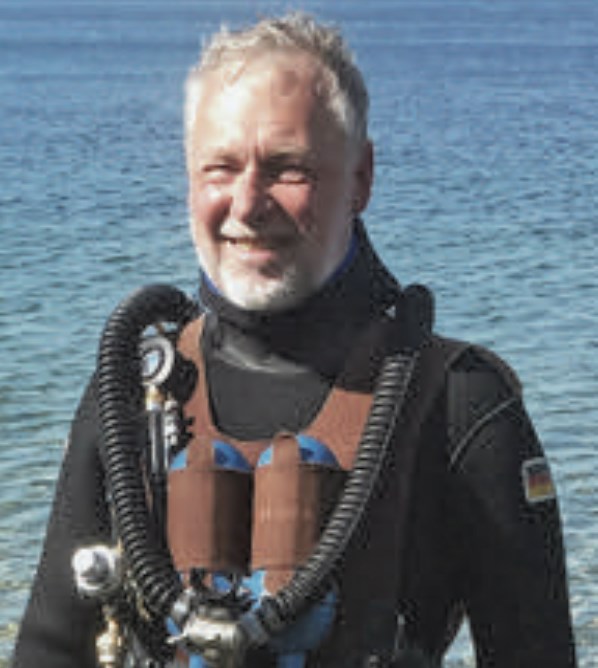
Helmut Knüfermann, born 1944, member of the Historische Tauchergesellschaft eV , was a swim diver in the German Navy. After studying physics, he worked for 34 years in the research, development and sale of medical implants. He has been diving since 1958 and since his retirement has been involved in the history of Dräger oxygen rebreathers for military use, which he collects and continues to use. Six years ago he started to delve into the biography of the maker of his rebreather “Dräger Lieutenant Lund II”, with which he has been diving since 1969.
I would like to take this opportunity to thank Helmut for allowing me to share his thorough research and knowledge of this device with the readers of my website. It is therefore with great pleasure that both article part I and part II about Lt Lund can be read by the readers of my website! Helmut I am very grateful to you for this and a big compliment for your fantastic article!

Therebreathersite was founded by Jan Willem Bech in 1999. After a diving career of many years, he decided to start technical diving in 1999. He immediately noticed that at that time there was almost no website that contained the history of closed breathing systems. The start for the website led to a huge collection that offered about 1,300 pages of information until 2019. In 2019, a fresh start was made with the website now freely available online for everyone. Therebreathersite is a source of information for divers, researchers, technicians and students. I hope you enjoy browsing the content!
